Engineering Risk Management Plan: Sydney Opera House, AS/NZS ISO 31000
VerifiedAdded on 2023/06/13
|15
|4570
|355
Report
AI Summary
This report presents a risk management plan for an engineering project, focusing on the Sydney Opera House. It covers stakeholder analysis, literature review, system boundaries, risk identification, analysis, evaluation, treatment, communication, and monitoring, all in accordance with AS/NZS ISO 31000. The report identifies risks related to the Opera House's design, sound quality, and stage size, proposing solutions such as improved sound systems and structural modifications. It also discusses risk assessment methods and the tolerability of risk, emphasizing the importance of risk communication and monitoring for successful risk management. Desklib provides past papers and solved assignments for students.
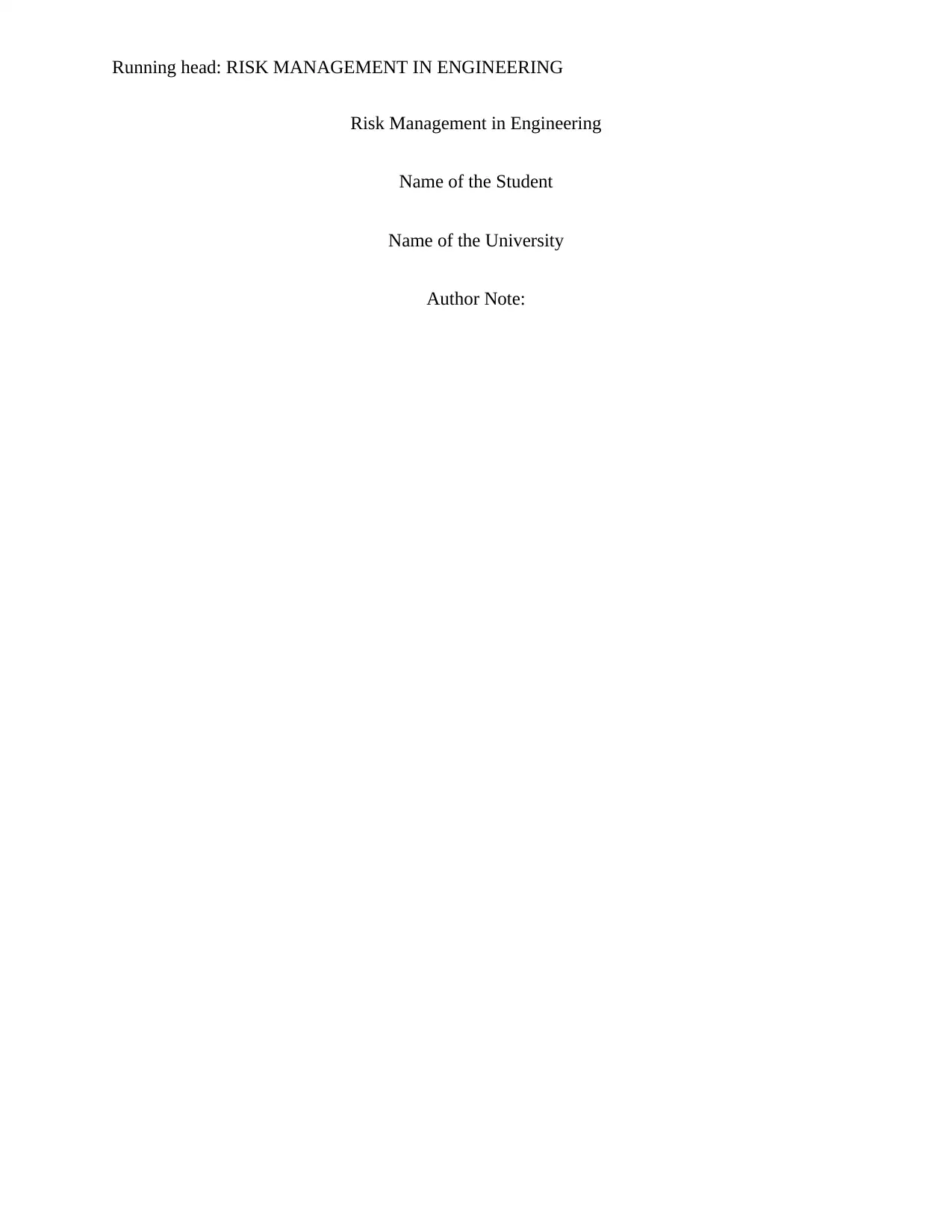
Running head: RISK MANAGEMENT IN ENGINEERING
Risk Management in Engineering
Name of the Student
Name of the University
Author Note:
Risk Management in Engineering
Name of the Student
Name of the University
Author Note:
Paraphrase This Document
Need a fresh take? Get an instant paraphrase of this document with our AI Paraphraser
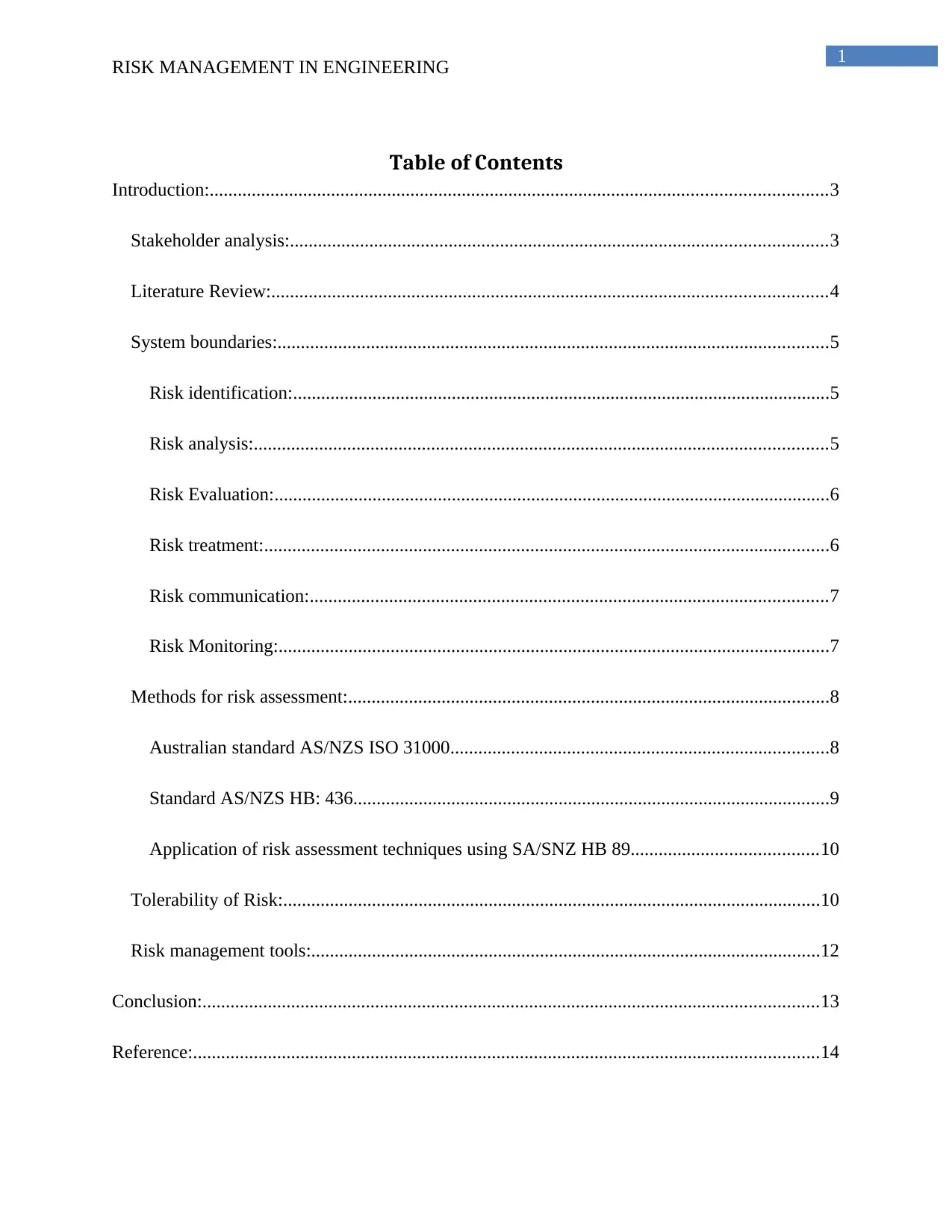
1
RISK MANAGEMENT IN ENGINEERING
Table of Contents
Introduction:....................................................................................................................................3
Stakeholder analysis:...................................................................................................................3
Literature Review:.......................................................................................................................4
System boundaries:......................................................................................................................5
Risk identification:...................................................................................................................5
Risk analysis:...........................................................................................................................5
Risk Evaluation:.......................................................................................................................6
Risk treatment:.........................................................................................................................6
Risk communication:...............................................................................................................7
Risk Monitoring:......................................................................................................................7
Methods for risk assessment:.......................................................................................................8
Australian standard AS/NZS ISO 31000.................................................................................8
Standard AS/NZS HB: 436......................................................................................................9
Application of risk assessment techniques using SA/SNZ HB 89........................................10
Tolerability of Risk:...................................................................................................................10
Risk management tools:.............................................................................................................12
Conclusion:....................................................................................................................................13
Reference:......................................................................................................................................14
RISK MANAGEMENT IN ENGINEERING
Table of Contents
Introduction:....................................................................................................................................3
Stakeholder analysis:...................................................................................................................3
Literature Review:.......................................................................................................................4
System boundaries:......................................................................................................................5
Risk identification:...................................................................................................................5
Risk analysis:...........................................................................................................................5
Risk Evaluation:.......................................................................................................................6
Risk treatment:.........................................................................................................................6
Risk communication:...............................................................................................................7
Risk Monitoring:......................................................................................................................7
Methods for risk assessment:.......................................................................................................8
Australian standard AS/NZS ISO 31000.................................................................................8
Standard AS/NZS HB: 436......................................................................................................9
Application of risk assessment techniques using SA/SNZ HB 89........................................10
Tolerability of Risk:...................................................................................................................10
Risk management tools:.............................................................................................................12
Conclusion:....................................................................................................................................13
Reference:......................................................................................................................................14
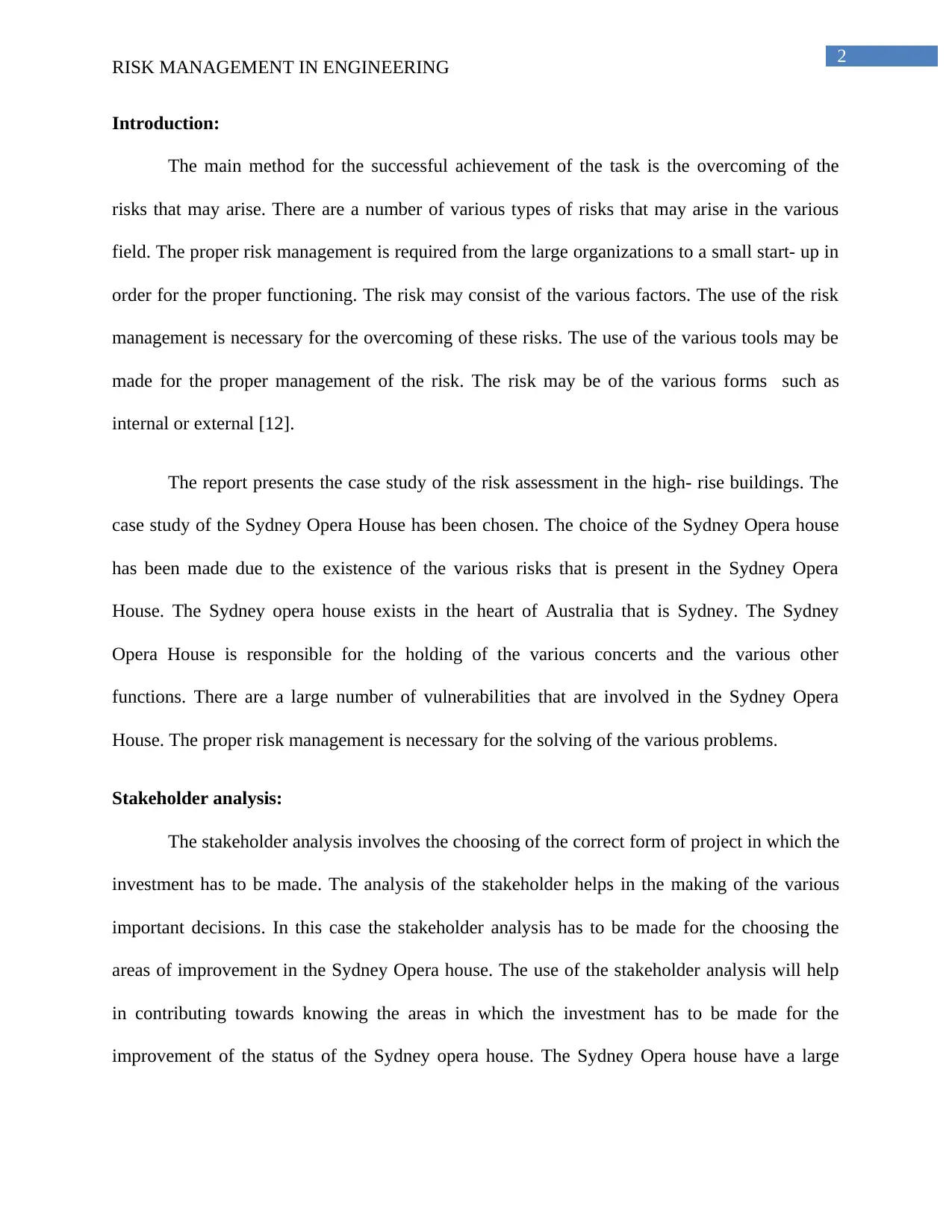
2
RISK MANAGEMENT IN ENGINEERING
Introduction:
The main method for the successful achievement of the task is the overcoming of the
risks that may arise. There are a number of various types of risks that may arise in the various
field. The proper risk management is required from the large organizations to a small start- up in
order for the proper functioning. The risk may consist of the various factors. The use of the risk
management is necessary for the overcoming of these risks. The use of the various tools may be
made for the proper management of the risk. The risk may be of the various forms such as
internal or external [12].
The report presents the case study of the risk assessment in the high- rise buildings. The
case study of the Sydney Opera House has been chosen. The choice of the Sydney Opera house
has been made due to the existence of the various risks that is present in the Sydney Opera
House. The Sydney opera house exists in the heart of Australia that is Sydney. The Sydney
Opera House is responsible for the holding of the various concerts and the various other
functions. There are a large number of vulnerabilities that are involved in the Sydney Opera
House. The proper risk management is necessary for the solving of the various problems.
Stakeholder analysis:
The stakeholder analysis involves the choosing of the correct form of project in which the
investment has to be made. The analysis of the stakeholder helps in the making of the various
important decisions. In this case the stakeholder analysis has to be made for the choosing the
areas of improvement in the Sydney Opera house. The use of the stakeholder analysis will help
in contributing towards knowing the areas in which the investment has to be made for the
improvement of the status of the Sydney opera house. The Sydney Opera house have a large
RISK MANAGEMENT IN ENGINEERING
Introduction:
The main method for the successful achievement of the task is the overcoming of the
risks that may arise. There are a number of various types of risks that may arise in the various
field. The proper risk management is required from the large organizations to a small start- up in
order for the proper functioning. The risk may consist of the various factors. The use of the risk
management is necessary for the overcoming of these risks. The use of the various tools may be
made for the proper management of the risk. The risk may be of the various forms such as
internal or external [12].
The report presents the case study of the risk assessment in the high- rise buildings. The
case study of the Sydney Opera House has been chosen. The choice of the Sydney Opera house
has been made due to the existence of the various risks that is present in the Sydney Opera
House. The Sydney opera house exists in the heart of Australia that is Sydney. The Sydney
Opera House is responsible for the holding of the various concerts and the various other
functions. There are a large number of vulnerabilities that are involved in the Sydney Opera
House. The proper risk management is necessary for the solving of the various problems.
Stakeholder analysis:
The stakeholder analysis involves the choosing of the correct form of project in which the
investment has to be made. The analysis of the stakeholder helps in the making of the various
important decisions. In this case the stakeholder analysis has to be made for the choosing the
areas of improvement in the Sydney Opera house. The use of the stakeholder analysis will help
in contributing towards knowing the areas in which the investment has to be made for the
improvement of the status of the Sydney opera house. The Sydney Opera house have a large
⊘ This is a preview!⊘
Do you want full access?
Subscribe today to unlock all pages.

Trusted by 1+ million students worldwide
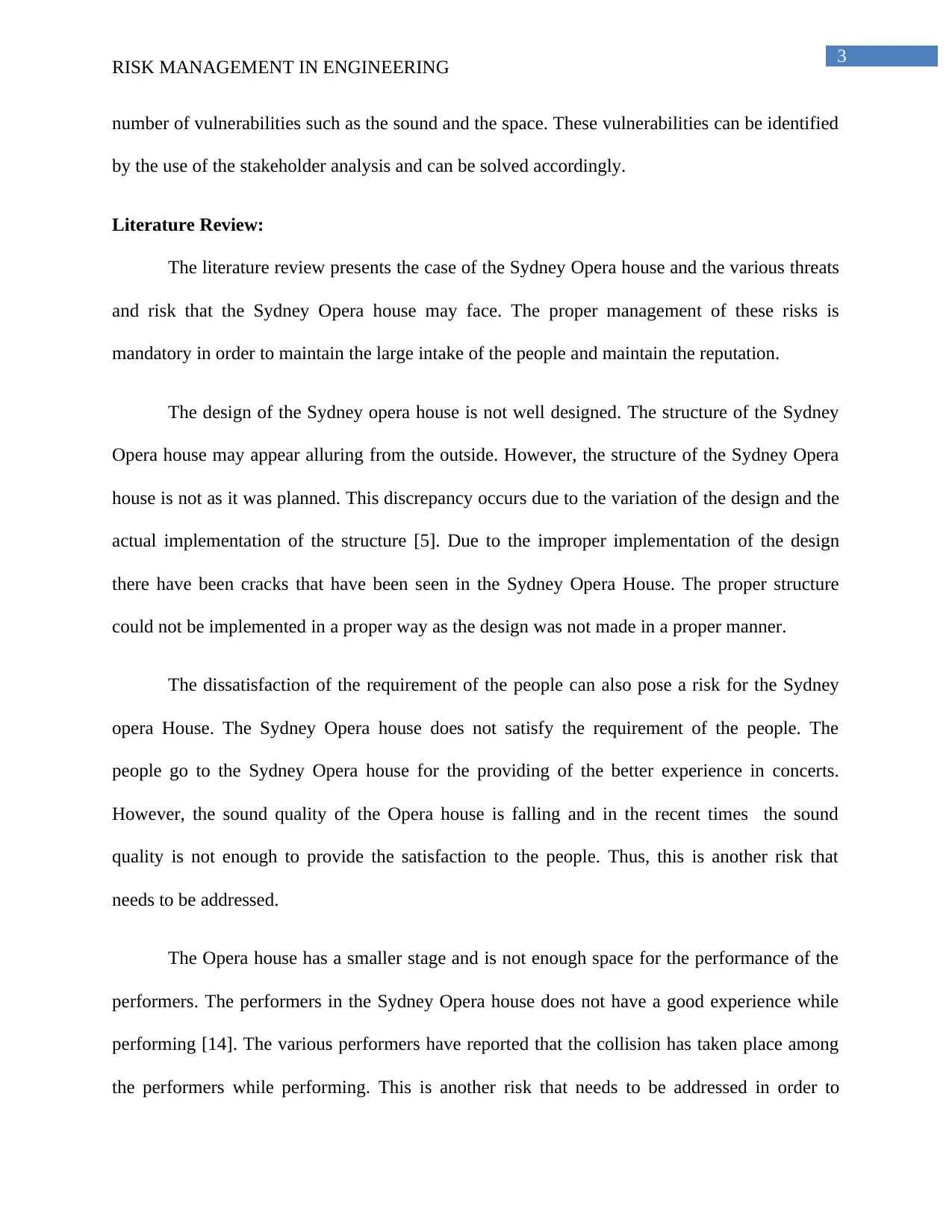
3
RISK MANAGEMENT IN ENGINEERING
number of vulnerabilities such as the sound and the space. These vulnerabilities can be identified
by the use of the stakeholder analysis and can be solved accordingly.
Literature Review:
The literature review presents the case of the Sydney Opera house and the various threats
and risk that the Sydney Opera house may face. The proper management of these risks is
mandatory in order to maintain the large intake of the people and maintain the reputation.
The design of the Sydney opera house is not well designed. The structure of the Sydney
Opera house may appear alluring from the outside. However, the structure of the Sydney Opera
house is not as it was planned. This discrepancy occurs due to the variation of the design and the
actual implementation of the structure [5]. Due to the improper implementation of the design
there have been cracks that have been seen in the Sydney Opera House. The proper structure
could not be implemented in a proper way as the design was not made in a proper manner.
The dissatisfaction of the requirement of the people can also pose a risk for the Sydney
opera House. The Sydney Opera house does not satisfy the requirement of the people. The
people go to the Sydney Opera house for the providing of the better experience in concerts.
However, the sound quality of the Opera house is falling and in the recent times the sound
quality is not enough to provide the satisfaction to the people. Thus, this is another risk that
needs to be addressed.
The Opera house has a smaller stage and is not enough space for the performance of the
performers. The performers in the Sydney Opera house does not have a good experience while
performing [14]. The various performers have reported that the collision has taken place among
the performers while performing. This is another risk that needs to be addressed in order to
RISK MANAGEMENT IN ENGINEERING
number of vulnerabilities such as the sound and the space. These vulnerabilities can be identified
by the use of the stakeholder analysis and can be solved accordingly.
Literature Review:
The literature review presents the case of the Sydney Opera house and the various threats
and risk that the Sydney Opera house may face. The proper management of these risks is
mandatory in order to maintain the large intake of the people and maintain the reputation.
The design of the Sydney opera house is not well designed. The structure of the Sydney
Opera house may appear alluring from the outside. However, the structure of the Sydney Opera
house is not as it was planned. This discrepancy occurs due to the variation of the design and the
actual implementation of the structure [5]. Due to the improper implementation of the design
there have been cracks that have been seen in the Sydney Opera House. The proper structure
could not be implemented in a proper way as the design was not made in a proper manner.
The dissatisfaction of the requirement of the people can also pose a risk for the Sydney
opera House. The Sydney Opera house does not satisfy the requirement of the people. The
people go to the Sydney Opera house for the providing of the better experience in concerts.
However, the sound quality of the Opera house is falling and in the recent times the sound
quality is not enough to provide the satisfaction to the people. Thus, this is another risk that
needs to be addressed.
The Opera house has a smaller stage and is not enough space for the performance of the
performers. The performers in the Sydney Opera house does not have a good experience while
performing [14]. The various performers have reported that the collision has taken place among
the performers while performing. This is another risk that needs to be addressed in order to
Paraphrase This Document
Need a fresh take? Get an instant paraphrase of this document with our AI Paraphraser
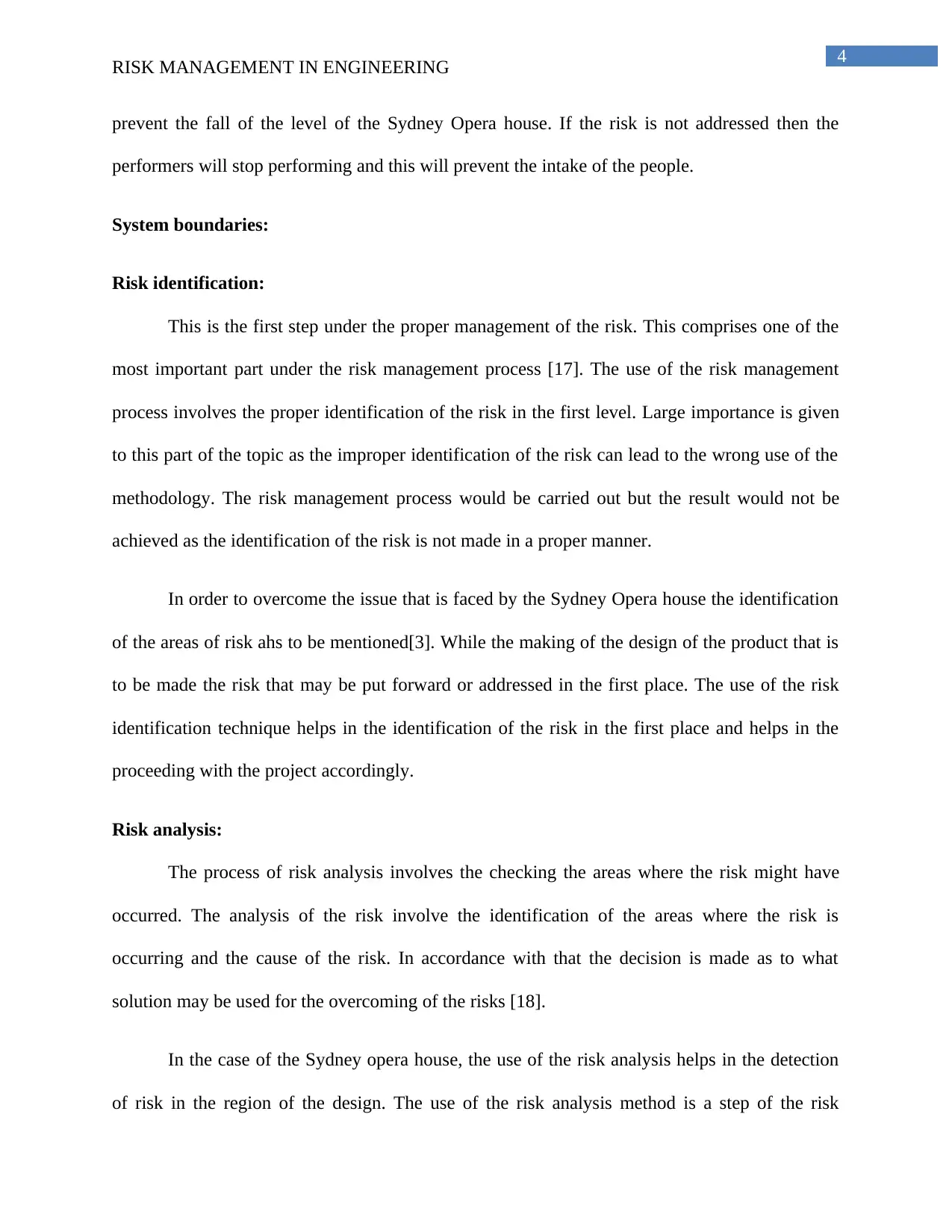
4
RISK MANAGEMENT IN ENGINEERING
prevent the fall of the level of the Sydney Opera house. If the risk is not addressed then the
performers will stop performing and this will prevent the intake of the people.
System boundaries:
Risk identification:
This is the first step under the proper management of the risk. This comprises one of the
most important part under the risk management process [17]. The use of the risk management
process involves the proper identification of the risk in the first level. Large importance is given
to this part of the topic as the improper identification of the risk can lead to the wrong use of the
methodology. The risk management process would be carried out but the result would not be
achieved as the identification of the risk is not made in a proper manner.
In order to overcome the issue that is faced by the Sydney Opera house the identification
of the areas of risk ahs to be mentioned[3]. While the making of the design of the product that is
to be made the risk that may be put forward or addressed in the first place. The use of the risk
identification technique helps in the identification of the risk in the first place and helps in the
proceeding with the project accordingly.
Risk analysis:
The process of risk analysis involves the checking the areas where the risk might have
occurred. The analysis of the risk involve the identification of the areas where the risk is
occurring and the cause of the risk. In accordance with that the decision is made as to what
solution may be used for the overcoming of the risks [18].
In the case of the Sydney opera house, the use of the risk analysis helps in the detection
of risk in the region of the design. The use of the risk analysis method is a step of the risk
RISK MANAGEMENT IN ENGINEERING
prevent the fall of the level of the Sydney Opera house. If the risk is not addressed then the
performers will stop performing and this will prevent the intake of the people.
System boundaries:
Risk identification:
This is the first step under the proper management of the risk. This comprises one of the
most important part under the risk management process [17]. The use of the risk management
process involves the proper identification of the risk in the first level. Large importance is given
to this part of the topic as the improper identification of the risk can lead to the wrong use of the
methodology. The risk management process would be carried out but the result would not be
achieved as the identification of the risk is not made in a proper manner.
In order to overcome the issue that is faced by the Sydney Opera house the identification
of the areas of risk ahs to be mentioned[3]. While the making of the design of the product that is
to be made the risk that may be put forward or addressed in the first place. The use of the risk
identification technique helps in the identification of the risk in the first place and helps in the
proceeding with the project accordingly.
Risk analysis:
The process of risk analysis involves the checking the areas where the risk might have
occurred. The analysis of the risk involve the identification of the areas where the risk is
occurring and the cause of the risk. In accordance with that the decision is made as to what
solution may be used for the overcoming of the risks [18].
In the case of the Sydney opera house, the use of the risk analysis helps in the detection
of risk in the region of the design. The use of the risk analysis method is a step of the risk
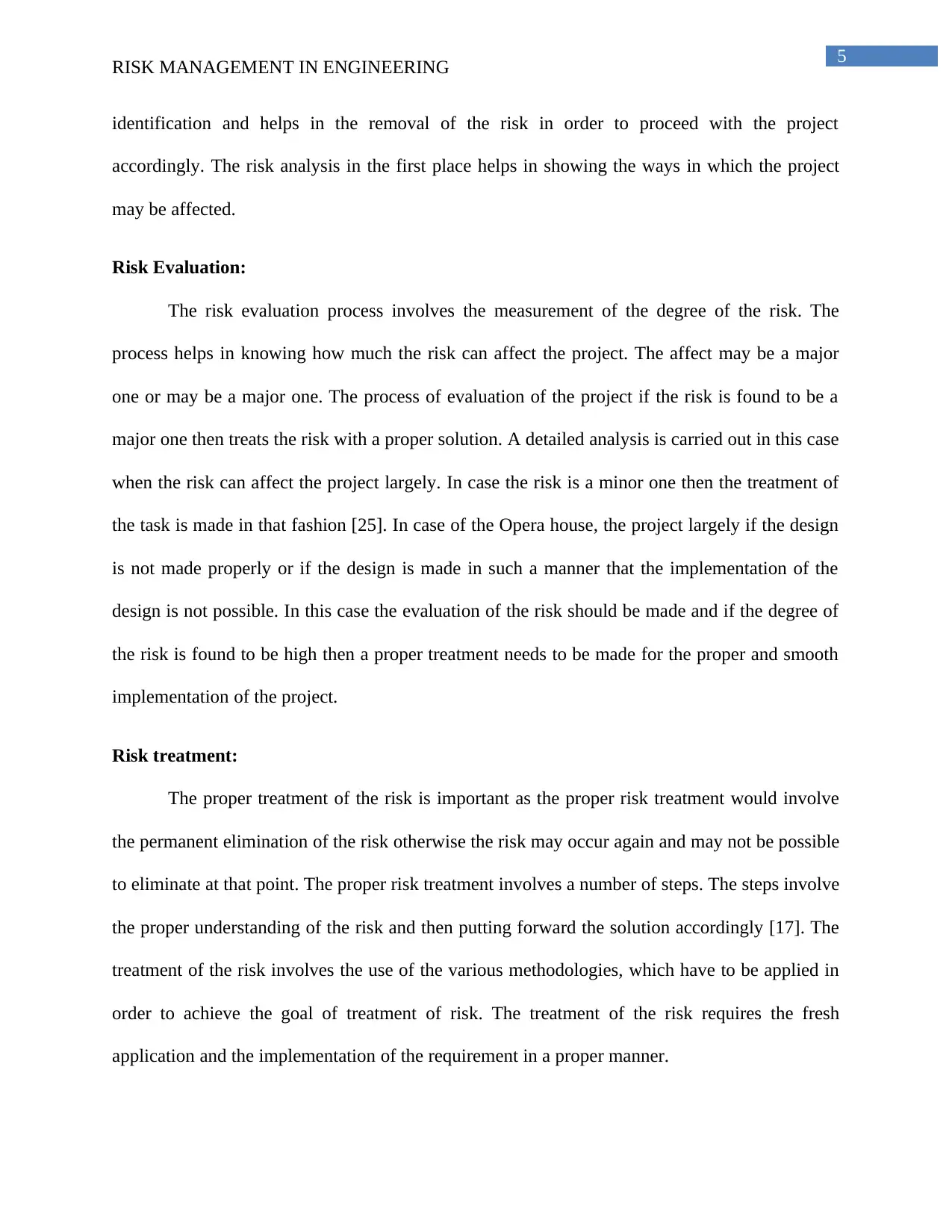
5
RISK MANAGEMENT IN ENGINEERING
identification and helps in the removal of the risk in order to proceed with the project
accordingly. The risk analysis in the first place helps in showing the ways in which the project
may be affected.
Risk Evaluation:
The risk evaluation process involves the measurement of the degree of the risk. The
process helps in knowing how much the risk can affect the project. The affect may be a major
one or may be a major one. The process of evaluation of the project if the risk is found to be a
major one then treats the risk with a proper solution. A detailed analysis is carried out in this case
when the risk can affect the project largely. In case the risk is a minor one then the treatment of
the task is made in that fashion [25]. In case of the Opera house, the project largely if the design
is not made properly or if the design is made in such a manner that the implementation of the
design is not possible. In this case the evaluation of the risk should be made and if the degree of
the risk is found to be high then a proper treatment needs to be made for the proper and smooth
implementation of the project.
Risk treatment:
The proper treatment of the risk is important as the proper risk treatment would involve
the permanent elimination of the risk otherwise the risk may occur again and may not be possible
to eliminate at that point. The proper risk treatment involves a number of steps. The steps involve
the proper understanding of the risk and then putting forward the solution accordingly [17]. The
treatment of the risk involves the use of the various methodologies, which have to be applied in
order to achieve the goal of treatment of risk. The treatment of the risk requires the fresh
application and the implementation of the requirement in a proper manner.
RISK MANAGEMENT IN ENGINEERING
identification and helps in the removal of the risk in order to proceed with the project
accordingly. The risk analysis in the first place helps in showing the ways in which the project
may be affected.
Risk Evaluation:
The risk evaluation process involves the measurement of the degree of the risk. The
process helps in knowing how much the risk can affect the project. The affect may be a major
one or may be a major one. The process of evaluation of the project if the risk is found to be a
major one then treats the risk with a proper solution. A detailed analysis is carried out in this case
when the risk can affect the project largely. In case the risk is a minor one then the treatment of
the task is made in that fashion [25]. In case of the Opera house, the project largely if the design
is not made properly or if the design is made in such a manner that the implementation of the
design is not possible. In this case the evaluation of the risk should be made and if the degree of
the risk is found to be high then a proper treatment needs to be made for the proper and smooth
implementation of the project.
Risk treatment:
The proper treatment of the risk is important as the proper risk treatment would involve
the permanent elimination of the risk otherwise the risk may occur again and may not be possible
to eliminate at that point. The proper risk treatment involves a number of steps. The steps involve
the proper understanding of the risk and then putting forward the solution accordingly [17]. The
treatment of the risk involves the use of the various methodologies, which have to be applied in
order to achieve the goal of treatment of risk. The treatment of the risk requires the fresh
application and the implementation of the requirement in a proper manner.
⊘ This is a preview!⊘
Do you want full access?
Subscribe today to unlock all pages.

Trusted by 1+ million students worldwide
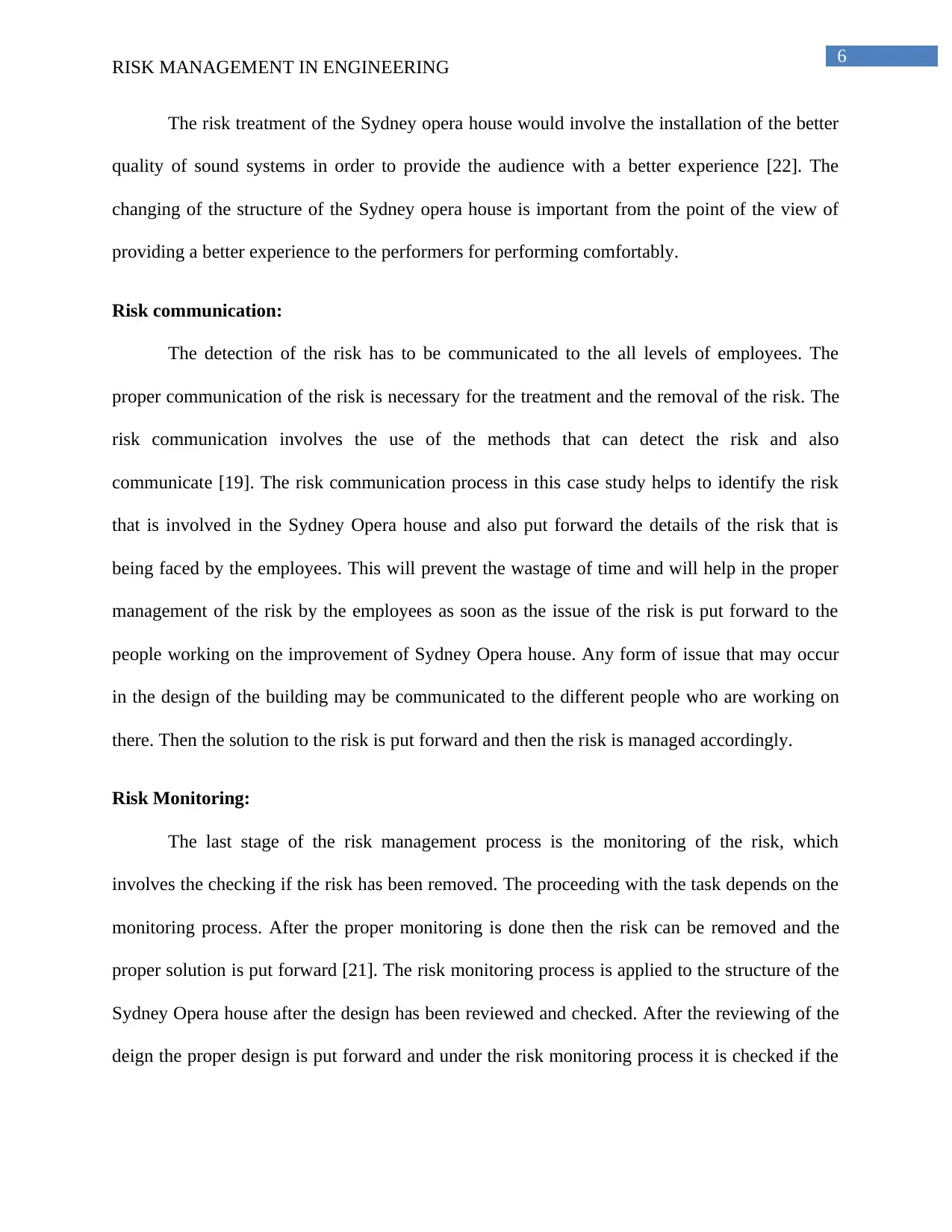
6
RISK MANAGEMENT IN ENGINEERING
The risk treatment of the Sydney opera house would involve the installation of the better
quality of sound systems in order to provide the audience with a better experience [22]. The
changing of the structure of the Sydney opera house is important from the point of the view of
providing a better experience to the performers for performing comfortably.
Risk communication:
The detection of the risk has to be communicated to the all levels of employees. The
proper communication of the risk is necessary for the treatment and the removal of the risk. The
risk communication involves the use of the methods that can detect the risk and also
communicate [19]. The risk communication process in this case study helps to identify the risk
that is involved in the Sydney Opera house and also put forward the details of the risk that is
being faced by the employees. This will prevent the wastage of time and will help in the proper
management of the risk by the employees as soon as the issue of the risk is put forward to the
people working on the improvement of Sydney Opera house. Any form of issue that may occur
in the design of the building may be communicated to the different people who are working on
there. Then the solution to the risk is put forward and then the risk is managed accordingly.
Risk Monitoring:
The last stage of the risk management process is the monitoring of the risk, which
involves the checking if the risk has been removed. The proceeding with the task depends on the
monitoring process. After the proper monitoring is done then the risk can be removed and the
proper solution is put forward [21]. The risk monitoring process is applied to the structure of the
Sydney Opera house after the design has been reviewed and checked. After the reviewing of the
deign the proper design is put forward and under the risk monitoring process it is checked if the
RISK MANAGEMENT IN ENGINEERING
The risk treatment of the Sydney opera house would involve the installation of the better
quality of sound systems in order to provide the audience with a better experience [22]. The
changing of the structure of the Sydney opera house is important from the point of the view of
providing a better experience to the performers for performing comfortably.
Risk communication:
The detection of the risk has to be communicated to the all levels of employees. The
proper communication of the risk is necessary for the treatment and the removal of the risk. The
risk communication involves the use of the methods that can detect the risk and also
communicate [19]. The risk communication process in this case study helps to identify the risk
that is involved in the Sydney Opera house and also put forward the details of the risk that is
being faced by the employees. This will prevent the wastage of time and will help in the proper
management of the risk by the employees as soon as the issue of the risk is put forward to the
people working on the improvement of Sydney Opera house. Any form of issue that may occur
in the design of the building may be communicated to the different people who are working on
there. Then the solution to the risk is put forward and then the risk is managed accordingly.
Risk Monitoring:
The last stage of the risk management process is the monitoring of the risk, which
involves the checking if the risk has been removed. The proceeding with the task depends on the
monitoring process. After the proper monitoring is done then the risk can be removed and the
proper solution is put forward [21]. The risk monitoring process is applied to the structure of the
Sydney Opera house after the design has been reviewed and checked. After the reviewing of the
deign the proper design is put forward and under the risk monitoring process it is checked if the
Paraphrase This Document
Need a fresh take? Get an instant paraphrase of this document with our AI Paraphraser
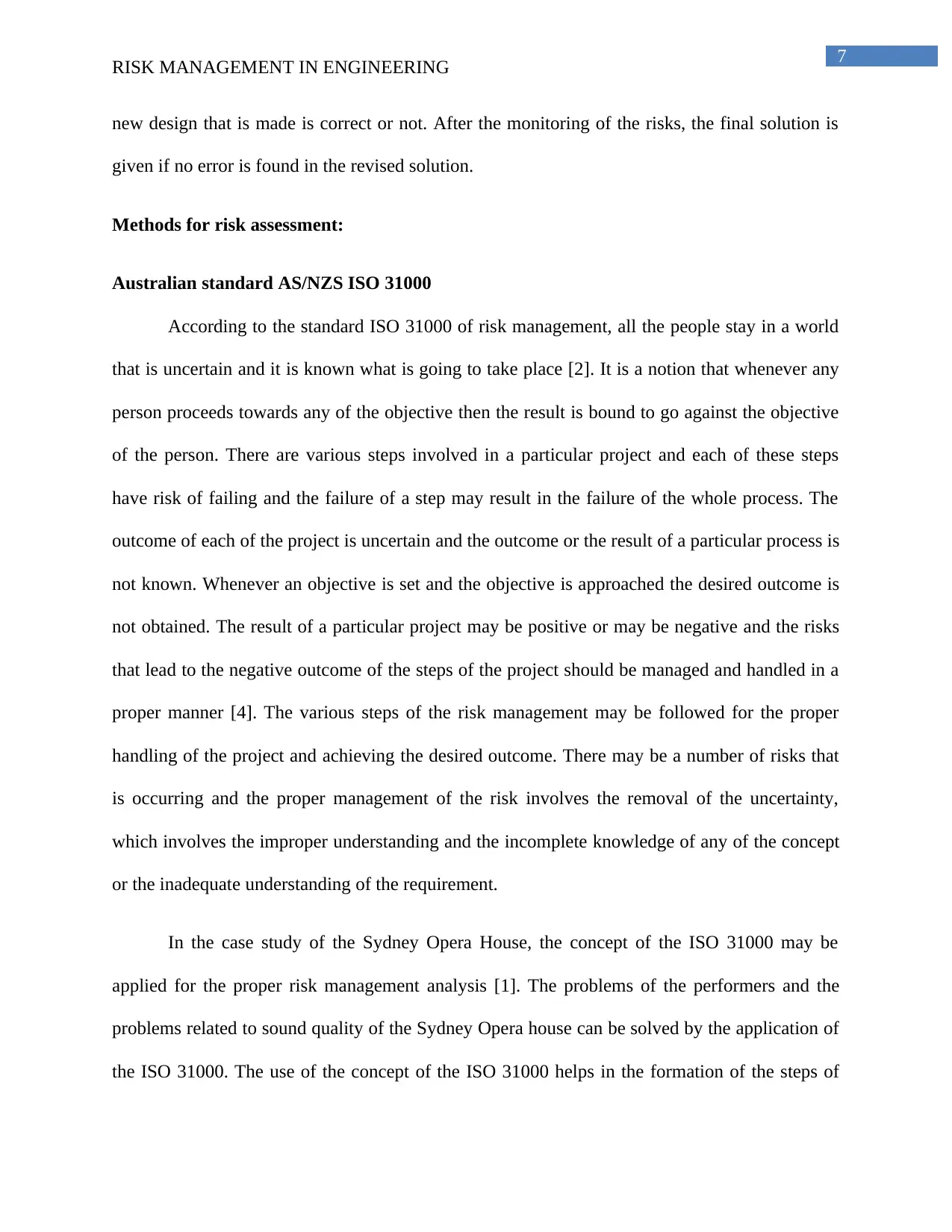
7
RISK MANAGEMENT IN ENGINEERING
new design that is made is correct or not. After the monitoring of the risks, the final solution is
given if no error is found in the revised solution.
Methods for risk assessment:
Australian standard AS/NZS ISO 31000
According to the standard ISO 31000 of risk management, all the people stay in a world
that is uncertain and it is known what is going to take place [2]. It is a notion that whenever any
person proceeds towards any of the objective then the result is bound to go against the objective
of the person. There are various steps involved in a particular project and each of these steps
have risk of failing and the failure of a step may result in the failure of the whole process. The
outcome of each of the project is uncertain and the outcome or the result of a particular process is
not known. Whenever an objective is set and the objective is approached the desired outcome is
not obtained. The result of a particular project may be positive or may be negative and the risks
that lead to the negative outcome of the steps of the project should be managed and handled in a
proper manner [4]. The various steps of the risk management may be followed for the proper
handling of the project and achieving the desired outcome. There may be a number of risks that
is occurring and the proper management of the risk involves the removal of the uncertainty,
which involves the improper understanding and the incomplete knowledge of any of the concept
or the inadequate understanding of the requirement.
In the case study of the Sydney Opera House, the concept of the ISO 31000 may be
applied for the proper risk management analysis [1]. The problems of the performers and the
problems related to sound quality of the Sydney Opera house can be solved by the application of
the ISO 31000. The use of the concept of the ISO 31000 helps in the formation of the steps of
RISK MANAGEMENT IN ENGINEERING
new design that is made is correct or not. After the monitoring of the risks, the final solution is
given if no error is found in the revised solution.
Methods for risk assessment:
Australian standard AS/NZS ISO 31000
According to the standard ISO 31000 of risk management, all the people stay in a world
that is uncertain and it is known what is going to take place [2]. It is a notion that whenever any
person proceeds towards any of the objective then the result is bound to go against the objective
of the person. There are various steps involved in a particular project and each of these steps
have risk of failing and the failure of a step may result in the failure of the whole process. The
outcome of each of the project is uncertain and the outcome or the result of a particular process is
not known. Whenever an objective is set and the objective is approached the desired outcome is
not obtained. The result of a particular project may be positive or may be negative and the risks
that lead to the negative outcome of the steps of the project should be managed and handled in a
proper manner [4]. The various steps of the risk management may be followed for the proper
handling of the project and achieving the desired outcome. There may be a number of risks that
is occurring and the proper management of the risk involves the removal of the uncertainty,
which involves the improper understanding and the incomplete knowledge of any of the concept
or the inadequate understanding of the requirement.
In the case study of the Sydney Opera House, the concept of the ISO 31000 may be
applied for the proper risk management analysis [1]. The problems of the performers and the
problems related to sound quality of the Sydney Opera house can be solved by the application of
the ISO 31000. The use of the concept of the ISO 31000 helps in the formation of the steps of

8
RISK MANAGEMENT IN ENGINEERING
how to solve the risks occurring in the Sydney Opera house. The use of the proper architecture is
made in the standard ISO 31000 and this helps in the proper implementation of the risk
management by the use of standard. Sydney Opera House implements the standard for the
creation of the structure and the architecture of the procedures that is taking place [16]. In the
proper working of the functions, the standard is needed as the use of the standard helps in the
creation of the structure and helps in knowing how to proceed with the task and the proper
planning of the project can be made.
Standard AS/NZS HB: 436
This is another standard that is used by the various organization for the reduction of the risks that
is occurring in the organizations. The use of this standard can be made in order to get rid of the
risk in an efficient manner. The increasing of the number of risks to the organization has made
the organization to use the standard in order to get rid of the risks[20]. The use of this standards
integrates all the standards and this helps in the effective and the efficient avoidance of the risk.
The use of this standards is generally made by the organizations in order to provide help to the
various organizations in order to get established and make the business successful. The use of the
arrangement is also made for the proper establishment of the business. The use of the standard
may also be made for the improvement of the current arrangements that are present in a
particular organization. Thus, case of this case study, this can be used for the implementing of
the arrangement of the various technologies that need to be implemented for the proper
establishment of the electronic product. The use of the standard can be made in order to improve
the efficiency of the systems in an efficient manner [7]. The main concept of this standard is the
for the proper risk management the individuals concerns and the individual risks need to be
addressed and this concept also helps in case of the engineering devices. The devices involved in
RISK MANAGEMENT IN ENGINEERING
how to solve the risks occurring in the Sydney Opera house. The use of the proper architecture is
made in the standard ISO 31000 and this helps in the proper implementation of the risk
management by the use of standard. Sydney Opera House implements the standard for the
creation of the structure and the architecture of the procedures that is taking place [16]. In the
proper working of the functions, the standard is needed as the use of the standard helps in the
creation of the structure and helps in knowing how to proceed with the task and the proper
planning of the project can be made.
Standard AS/NZS HB: 436
This is another standard that is used by the various organization for the reduction of the risks that
is occurring in the organizations. The use of this standard can be made in order to get rid of the
risk in an efficient manner. The increasing of the number of risks to the organization has made
the organization to use the standard in order to get rid of the risks[20]. The use of this standards
integrates all the standards and this helps in the effective and the efficient avoidance of the risk.
The use of this standards is generally made by the organizations in order to provide help to the
various organizations in order to get established and make the business successful. The use of the
arrangement is also made for the proper establishment of the business. The use of the standard
may also be made for the improvement of the current arrangements that are present in a
particular organization. Thus, case of this case study, this can be used for the implementing of
the arrangement of the various technologies that need to be implemented for the proper
establishment of the electronic product. The use of the standard can be made in order to improve
the efficiency of the systems in an efficient manner [7]. The main concept of this standard is the
for the proper risk management the individuals concerns and the individual risks need to be
addressed and this concept also helps in case of the engineering devices. The devices involved in
⊘ This is a preview!⊘
Do you want full access?
Subscribe today to unlock all pages.

Trusted by 1+ million students worldwide

9
RISK MANAGEMENT IN ENGINEERING
engineering also requires the step by step process for the working and the requirements have to
be addressed individually for the successful implementation of the concept.
Application of risk assessment techniques using SA/SNZ HB 89.
This standard involves the various steps in order to carry out the risk management procedure.
The standard follows well- defined structure in order to achieve the successful outcome of risk
management. The risk management standard follows the planning of the risk, the proper analysis
of the risk, the proper evaluation and the treatment of the risk. Following this process helps in the
identification of the various risks that are involved and helps in the risk management process.
The use of the standard can be extended to be used in the field of engineering [23]. The use of
the standard can be made as there are a number of risks that are involved in the field of
engineering. In the case of Sydney Opera House, the use of the concept of the standard can help
in the proper execution of the project. In the section of the designing of the project, all the steps
have to be carried out properly and the use of this standard addresses all the necessities and the
requirements that are to be addressed in the individual level and also at the overall level. By
following this standard all the requirements needed for the risk management of the Sydney Opera
house can be achieved and the issues may be overcome.
Tolerability of Risk:
The tolerability to risk is another factor or parameter that is helpful in designating the
level of risk that is occurring. The tolerability to risk table is presented below which shows the
various factors that contribute to the cause of the risk. The level of the risk that is whether the
risk is high or low is determined by the use of this table. On the basis of that the tolerability of
risk table is made. On the basis of the tolerability of risk table the factor of risk that comprises
RISK MANAGEMENT IN ENGINEERING
engineering also requires the step by step process for the working and the requirements have to
be addressed individually for the successful implementation of the concept.
Application of risk assessment techniques using SA/SNZ HB 89.
This standard involves the various steps in order to carry out the risk management procedure.
The standard follows well- defined structure in order to achieve the successful outcome of risk
management. The risk management standard follows the planning of the risk, the proper analysis
of the risk, the proper evaluation and the treatment of the risk. Following this process helps in the
identification of the various risks that are involved and helps in the risk management process.
The use of the standard can be extended to be used in the field of engineering [23]. The use of
the standard can be made as there are a number of risks that are involved in the field of
engineering. In the case of Sydney Opera House, the use of the concept of the standard can help
in the proper execution of the project. In the section of the designing of the project, all the steps
have to be carried out properly and the use of this standard addresses all the necessities and the
requirements that are to be addressed in the individual level and also at the overall level. By
following this standard all the requirements needed for the risk management of the Sydney Opera
house can be achieved and the issues may be overcome.
Tolerability of Risk:
The tolerability to risk is another factor or parameter that is helpful in designating the
level of risk that is occurring. The tolerability to risk table is presented below which shows the
various factors that contribute to the cause of the risk. The level of the risk that is whether the
risk is high or low is determined by the use of this table. On the basis of that the tolerability of
risk table is made. On the basis of the tolerability of risk table the factor of risk that comprises
Paraphrase This Document
Need a fresh take? Get an instant paraphrase of this document with our AI Paraphraser
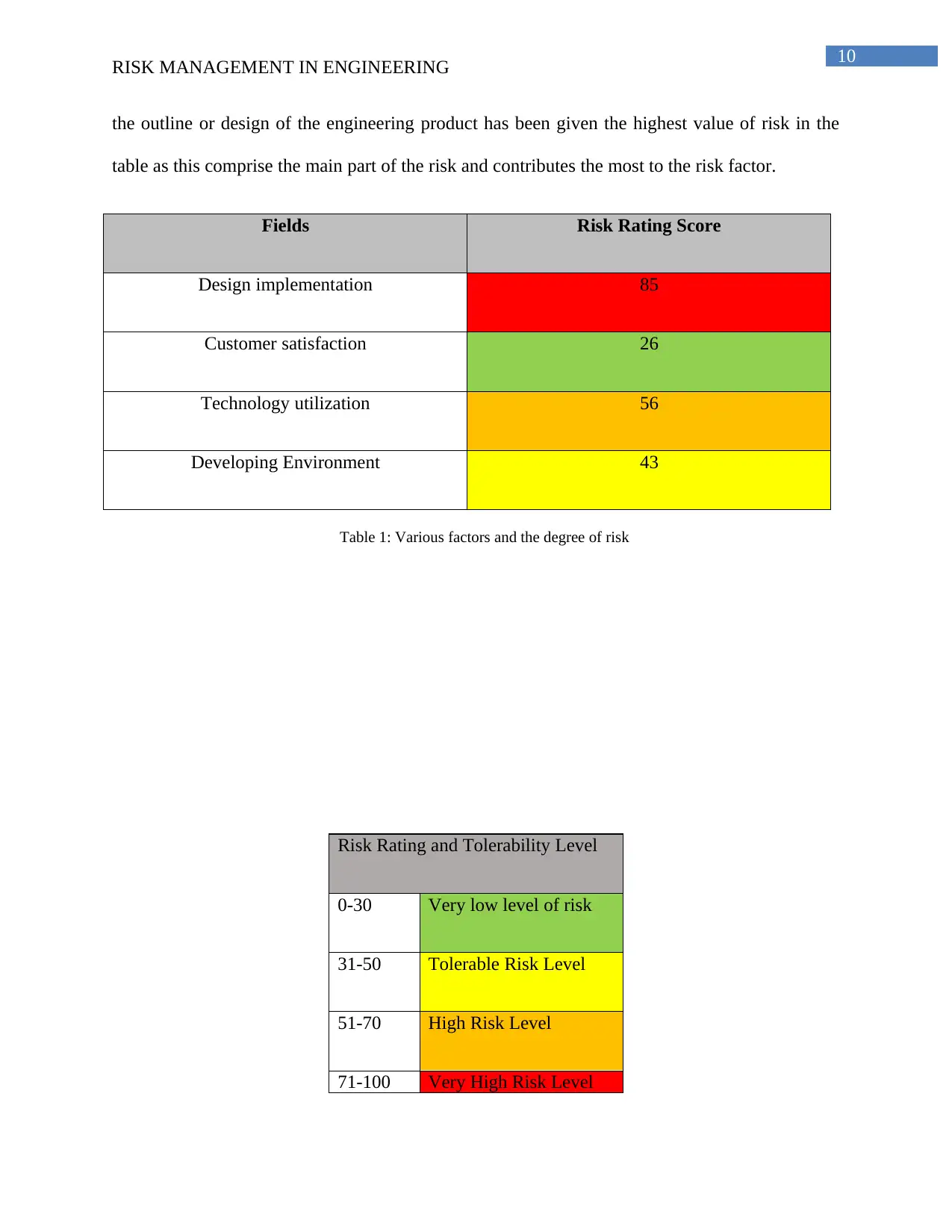
10
RISK MANAGEMENT IN ENGINEERING
the outline or design of the engineering product has been given the highest value of risk in the
table as this comprise the main part of the risk and contributes the most to the risk factor.
Fields Risk Rating Score
Design implementation 85
Customer satisfaction 26
Technology utilization 56
Developing Environment 43
Table 1: Various factors and the degree of risk
Risk Rating and Tolerability Level
0-30 Very low level of risk
31-50 Tolerable Risk Level
51-70 High Risk Level
71-100 Very High Risk Level
RISK MANAGEMENT IN ENGINEERING
the outline or design of the engineering product has been given the highest value of risk in the
table as this comprise the main part of the risk and contributes the most to the risk factor.
Fields Risk Rating Score
Design implementation 85
Customer satisfaction 26
Technology utilization 56
Developing Environment 43
Table 1: Various factors and the degree of risk
Risk Rating and Tolerability Level
0-30 Very low level of risk
31-50 Tolerable Risk Level
51-70 High Risk Level
71-100 Very High Risk Level
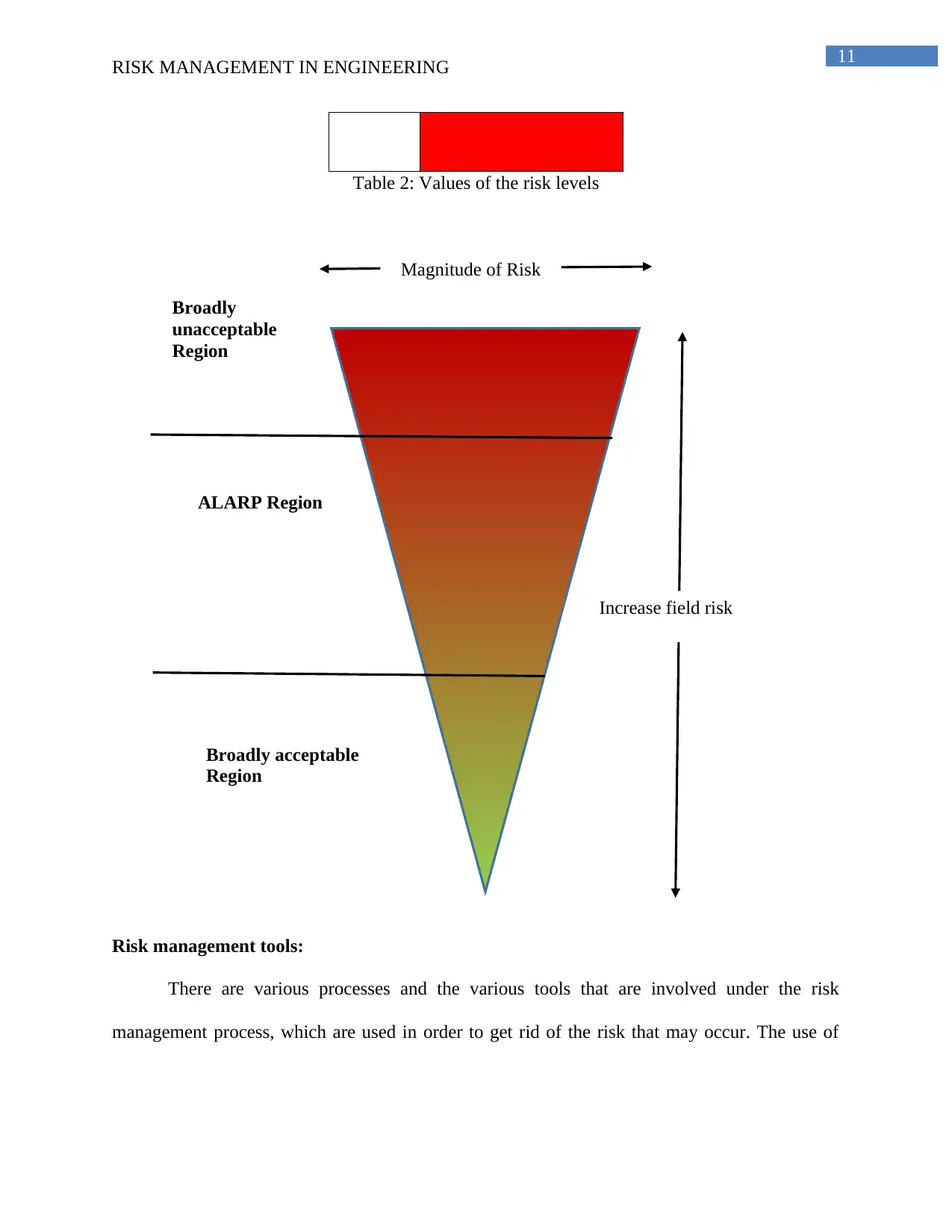
11
Broadly acceptable
Region
ALARP Region
Broadly
unacceptable
Region
Magnitude of Risk
Increase field risk
RISK MANAGEMENT IN ENGINEERING
Table 2: Values of the risk levels
Risk management tools:
There are various processes and the various tools that are involved under the risk
management process, which are used in order to get rid of the risk that may occur. The use of
Broadly acceptable
Region
ALARP Region
Broadly
unacceptable
Region
Magnitude of Risk
Increase field risk
RISK MANAGEMENT IN ENGINEERING
Table 2: Values of the risk levels
Risk management tools:
There are various processes and the various tools that are involved under the risk
management process, which are used in order to get rid of the risk that may occur. The use of
⊘ This is a preview!⊘
Do you want full access?
Subscribe today to unlock all pages.

Trusted by 1+ million students worldwide
1 out of 15
Related Documents
Your All-in-One AI-Powered Toolkit for Academic Success.
+13062052269
info@desklib.com
Available 24*7 on WhatsApp / Email
![[object Object]](/_next/static/media/star-bottom.7253800d.svg)
Unlock your academic potential
Copyright © 2020–2026 A2Z Services. All Rights Reserved. Developed and managed by ZUCOL.





